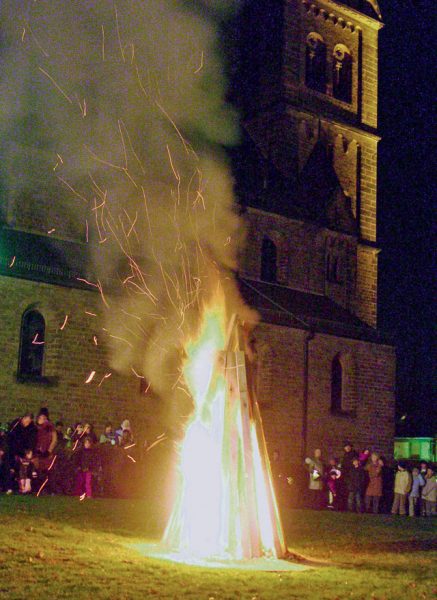
Each year after St. Martin’s parade through the town, a bonfire gets lit next to the church in Ramstein-Miesenbach.
Nov. 11 not only marks the beginning of the German carnival season but also St. Martin’s Day. Today Germans honor the patron of the poor and friend of the children, St. Martin.
Traditionally on the night of Nov. 11, Kindergarten children walk in processions through Kaiserslautern and villages in the KMC to honor Martin of Tours. They carry lanterns, which they crafted in kindergarten, and sing Martin songs. Usually the walk starts at a church and goes to a public square. A man on horseback dressed like a Roman soldier, Saint Martin, accompanies the children. When they reach the square, the Martin’s bonfire is lit and Martin’s pretzels are distributed.
Martin was born in the year 316 or 317 as the son of a Roman civil servant. At age 15, he joined the emperor’s cavalry.
One cold winter day, Martin was riding through country when a shivering beggar came his way asking for alms. Since Martin had neither food nor money, he cut his robe in half with his sword and gave a piece to the freezing man.
Supposedly, the following night Jesus appeared in Martin’s dream and explained how he had been the freezing beggar Martin had given half his robe to.
This event changed the soldier’s life. He left the army, got baptized and became a student of Hilarius, bishop of Poitiers, France. In 356, after Martin’s teacher was banned and after he failed to convert his father and others to the teachings of Hilarius, Martin left for an island near Genua, where he lived as a hermit.
In 360, Martin gave up his solitary life to join Hilarius again, who returned to Poitiers. In 361, he founded the first Gallic monastery in Liguge, France. In 371, the clergy and the people elected him bishop of Tours.
In 375, he established Marmoutier, a monastery for ascetic life and school for bishops.
Martin was still trying to evangelize pagans. On Nov. 8, 397, during a pastoral trip to Candes, he died. Thousands of monks, consecrated virgins and others went to his funeral Nov. 11.
Years later, a basilica with the St. Martin Abbey was built on top of Martin’s gravesite. King Chlodwig elected Martin as patron of the Franconians.
The tradition of the lanterns goes back to former times, when people lit candles to honor a saint and when lanterns were put up everywhere in town during a bishop’s visit. The custom of lighting a bonfire after the lantern procession represents the beginning of festivities. In former times, most of the work on the fields had been completed and now it was time to celebrate, drink and eat. Traditionally, a fat goose and sweet bread were served.
One legend says that St. Martin died after eating a whole goose at a single meal. Another legend says that Martin was hiding to avoid his election as bishop of Tours, but chattering geese revealed his hiding place. The tradition of eating a “Martin’s goose” at this time of year has been kept. Many restaurants in the KMC add Martin’s goose with dumplings and red cabbage to their menus.
Even on Christmas, Germans like to serve goose.
In Kaiserslautern, the lantern procession of St. Martin’s Church starts at 6 p.m. Monday at St. Martinsplatz at the beginning of Steinstrasse and ends in front of the Rathaus, where St. Martin will divide his coat and the bonfire will be lit.
In Ramstein village, festivities will start at 5:30 p.m. Tuesday in the Catholic church. Then the lantern procession with St. Martin on a horse and musicians will go through town. The St. Martin’s play will be presented, the bonfire will be lit and pretzels and Gluehwein will be available.
In Landstuhl city, St. Martin’s parade will start at 5:30 p.m. from St. Markus Church on Sonnenstrasse 45 and lead to Marienkapelle, Mary’s Chapel. Here the bonfire will be lit, and pretzels, bratwurst and Gluehwein will be offered.


